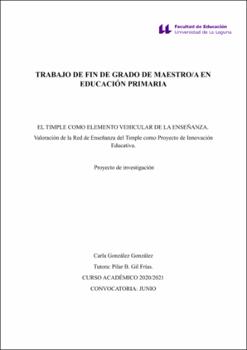El timple como elemento vehicular de la enseñanza: Valoración de la Red de Enseñanza del Timple como Proyecto de Innovación Educativa.
Autor
González González, CarlaFecha
2021Resumen
Las Islas Canarias se caracterizan por su riqueza cultural. La música tradicional o el
folklore es una de las principales manifestaciones de esta, que puede ser interpretada por
diferentes instrumentos, entre los que destaca, el timple. Este instrumento, símbolo del
patrimonio cultural y musical de Canarias, presenta diversas singularidades no sólo en su
tamaño sino también en su sonoridad, contando con tan sólo cinco cuerdas. La perspectiva del
instrumento que normalmente recordamos, es su vinculación tradicional con la música o el
folklore canario. Este proyecto de investigación tiene la finalidad de conocer y valorar el
timple como elemento didáctico en las aulas de Enseñanza Primaria de la Comunidad
Autónoma de Canarias. Para ello investigaremos sobre el instrumento, desde sus orígenes
hasta la actualidad, para posteriormente, evaluar su labor pedagógica a través del proyecto de
la Red de Enseñanza del Timple y, mediante la participación y colaboración del timplista D.
Germán López. La investigación se centrará en dicho proyecto basándose en una entrevista
realizada al asesor D. Roberto Jiménez, así como reflexiones, testimonios y aportaciones de
los diferentes docentes que están implicados en el proyecto educativo a través de un
cuestionario. D. Germán López, por otro lado, desarrollará su visión de la evolución
pedagógica del timple extrapolado a la enseñanza superior en el Conservatorio Superior de
Música de Canarias o enseñanza no reglada. Las principales conclusiones de esta
investigación reflejan que el timple ofrece numerosos beneficios educativos y didácticos, y
que su evolución permite dar lugar a nuevas visiones del instrumento, sin olvidar su raíz
tradicional. The Canary Islands are characterised by their cultural richness. Traditional music or
folklore is one of the main manifestations of this, which can be played by different
instruments, among which the timple stands out. This instrument, a symbol of the cultural and
musical heritage of the Canary Islands, has several singularities not only in its size but also in
its sonority, having only five strings. The perspective of the instrument that we usually
remember is its traditional link with Canarian music or folklore. The aim of this research
project is to discover and value the timple as a didactic element in primary school classrooms
in the Autonomous Community of the Canary Islands. To this end, we will investigate the
instrument, from its origins to the present day, in order to subsequently evaluate its
pedagogical work through the project of the Timple Teaching Network, with the participation
and collaboration of the timple player Germán López. The research will focus on this project
based on an interview with the advisor Roberto Jiménez, as well as reflections, testimonies
and contributions from the different teachers involved in the educational project through a
questionnaire. On the other hand, Mr. Germán López, will develop his vision of the
pedagogical evolution of the timple extrapolated to higher education at the Canarian Higher
Conservatory of Music or non-regulated education. The main conclusions of this research
reflect that the timple offers numerous educational and didactic benefits, and that its evolution
allows for new visions of the instrument, without forgetting its traditional roots Educación musical Educación Primaria Timple Folklore canario





